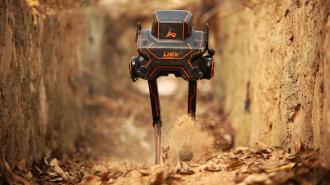We’ve seen robots that can hike mountains and ones that can take a beating, but China-based robotics company LimX Dynamics has now unveiled a bipedal robot that can do both at the same time.
The background: Building a robot that can do one thing in one specific environment — think of all the bots currently working on assembly lines — is hard enough, but LimX’s focus is on developing “general-purpose robots,” ones that can do many things in many environments.
It recently unveiled a humanoid robot and a wheeled quadruped (if you were traumatized by the Wheelers in “Return of Oz” as a child, maybe skip videos of the latter in action), and now, it’s added a bipedal robot named “P1” to its lineup.
Forest environments were not included in P1’s training simulations.
Meet P1: P1 is essentially just a pair of legs — think an AT-ST from “Star Wars,” but only about waist high and thankfully unarmed — and it’s trained to have “exceptional control and stability,” even when walking in incredibly challenging environments.
This training took place in computer simulations and made use of reinforcement learning, a technique that lets an AI learn through trial and error, with “rewards” given when it does something desirable.
Friendly hike: To demonstrate P1’s capabilities, LimX filmed the bipedal robot at China’s Tanglang Mountain, where it encountered grassy fields, rocky ditches, and steep, brush-covered slopes — environments that LimX says were not included in the robot’s training simulations.
In the video, P1 is able to keep its balance remarkably well, despite the rough, unfamiliar terrain and the occasional abuse from its human companion — at one point, the man hits the bot’s legs with a tree branch so hard that the branch breaks, yet P1 stays on its feet.
Looking ahead: P1 is listed as a product on LimX’s website, but it’s not clear what the company plans to charge for the bipedal robot, when people can buy one, or what the intended use cases are.
Based on the demo video, though, it’s easy to imagine P1s being used for search-and-rescue missions, where it could team up with cyborg cockroaches, robotic snakes, and scream-sensing drones to save people in peril.
We’d love to hear from you! If you have a comment about this article or if you have a tip for a future Freethink story, please email us at tips@freethink.com.
